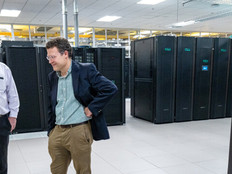Tablets Hit Full Stride With Agencies
In the past, it took a team of clinicians to register veterans and keep track of their paperwork at Veterans Affairs Department flu clinics. But this season, a single clinician armed with a tablet computer welcomes veterans at some hospitals. The clinician can record answers to prescreening questions about health factors such as allergies, email veterans information and create progress notes that are automatically stored in veterans' electronic health records.
These capabilities, which aim to improve both the speed and quality of the department's services for veterans, stem from a 10,000-tablet deployment at 19 sites across the country. During the first phase of the rollout, users could connect to the agency's network, access their email and use vetted commercial medical applications. The second phase, which began this fall, introduced VA-specific apps (such as the flu registration system) that automatically feed data into the agency's records.
"Seamless integration is our goal," says DJ Kachman, director of mobile technologies and security assurance at the VA. "You give the user the tablet, and everything they do is tied back into current systems."
Expanding Horizons
When tablets first emerged on the scene a few years ago, agencies had no enterprise-specific apps, and the machines trailed far behind desktop and notebook PCs in computing power. Because of these limitations, tablets were sometimes seen as niche devices — giving workers the ability to take notes, send email and read documents on the go, but not much else.
But today, tablets are catching up with their bulkier brethren in computing power, and agencies such as the VA have found innovative ways to leverage the devices' touch screens and mobility. Some tablets can even be plugged into docking stations that connect them to full-size monitors and keyboards, helping to ease the transition from desktops and allowing some employees to use tablets as their primary computing device.
Percentage of U.S. adults who own a tablet computing device, up from 10 percent three years ago
SOURCE: Pew Research Center's Internet & American Life Project, "Mobile Technology Fact Sheet," January 2014
The VA isn't replacing users' notebooks and desktops with tablets just yet, but Dr. Neil Evans, co-director of connected health for the VA's Office of Information and Analytics, says it's a possibility in the near future. "I am sure, with a pilot that includes 10,000 providers, we're going to find certain providers for whom the mobile apps meet all of their requirements," he says. For example, homeless-outreach workers, whose jobs require them to be mobile, can use tablets to look up veterans in the VA's system, determine their eligibility for service and make notations on their records. "We'll be able to deliver that full functionality with our mobile apps," Evans says.
In addition to the VA's rollout, several other agencies are pushing toward more robust tablet use. The Bureau of Alcohol, Tobacco, Firearms and Explosives has announced plans to move about 2,000 employees away from notebooks, to tablet devices. And the Department of Transportation has deployed approximately 7,000 tablets.
The Right Tools
Ken Dulaney, vice president for mobile computing at Gartner, distinguishes between slate-style tablets and hybrid or convertible devices that function more like a notebook. The slate tablets, he says, work almost as "clipboard replacements" for recording data, while the two-in-one devices more easily replace notebooks or desktops.
The Federal Emergency Management Agency uses tablets in the field, both to register claims from disaster survivors and to record data and take photographs when conducting damage inspections. "Tablets, for us, are a critical tool that allow us to fulfill our mission," says Alex Amparo, deputy assistant administrator for recovery at FEMA.
While FEMA employees are indeed using tablets for some tasks that used to be done with pen and paper, Amparo says the clipboard analogy makes the agency's tablet initiative sound too "static." In fact, Amparo says, the devices allow FEMA's incident workforce to do things they couldn't before, such as instantly issue referrals to other organizations (connecting people, for example, with the Social Security Administration if they've lost their Social Security cards in a disaster). "It allows us to be much more interactive when we see disaster survivors."
A Rising Tide
The Army has deployed approximately 2,000 tablets on the business side of its operations. Although the Army and Defense Department have approved about 130 mobile applications for functions such as email and the creation of spreadsheets and presentations, tablets aren't the primary devices for most users. That may change soon, though, says Rick Walsh, chief of mobility at the Army's Office of the CIO/G-6.
"We haven't gotten to one device yet, but that is the goal," says Walsh. "We're looking for a single endpoint device, where you have one device to use in the office and on the road."
For now, Walsh says, tablets are particularly helpful for users who collect a lot of data in the field, such as those in the Army Corps of Engineers or Recruiting Command. But before tablets can fully replace an employee's notebook or desktop, Walsh says, the Army must first ensure that the devices have all the necessary applications and network access. "To get rid of laptops and desktops, I have to replace the entire infrastructure that's behind those devices," he says.
At the Customs and Border Protection agency, roughly 200 users have already moved completely to tablets as part of a pilot program. These aren't inspectors in the field (who would require ruggedized devices), but back-office workers who float between different buildings for meetings.
Susan K. Hutzell, executive director of enterprise networks and technology support at the agency, says some employees use the tablets alone, while others connect the devices to docking stations to replicate the desktop experience. "Because they are going from building to building, they really like it," Hutzell says. "They have their desktop with them, and it doesn't matter where they are. They are able to do their job."









